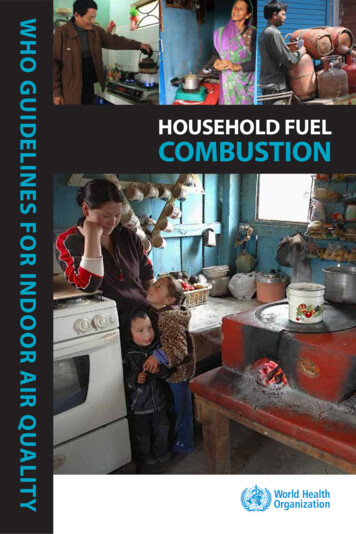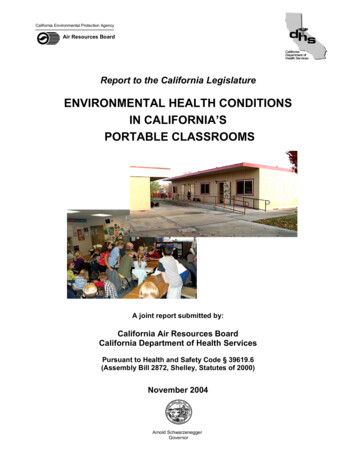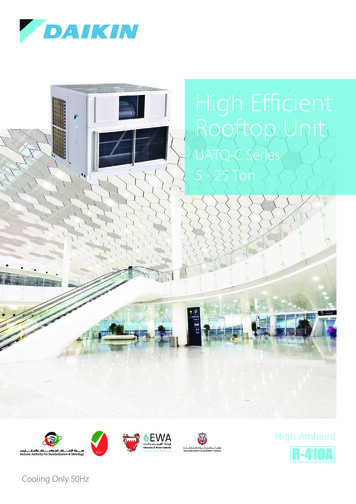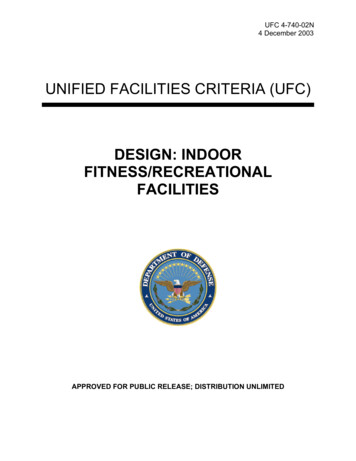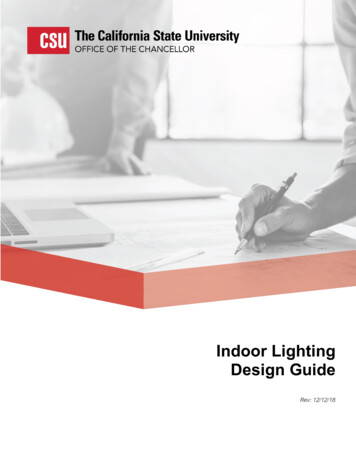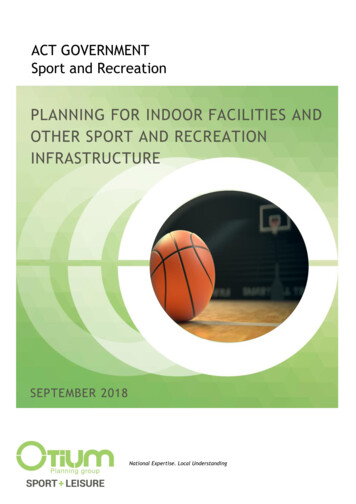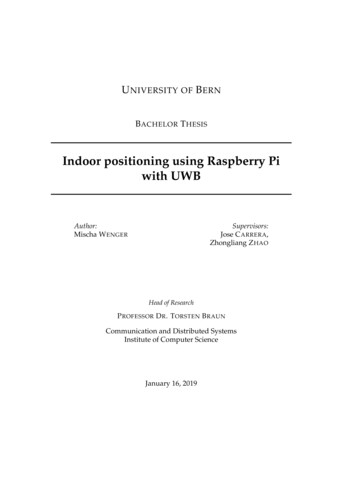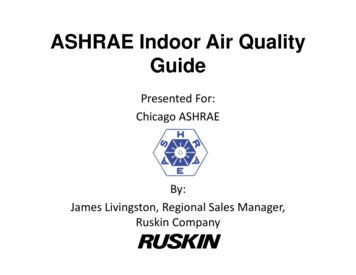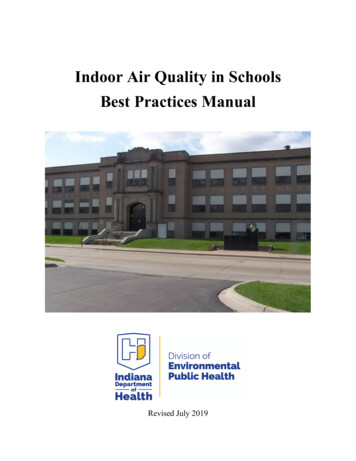
Transcription
Indoor Air Quality in SchoolsBest Practices ManualRevised July 2019
IntroductionApproximately one fifth of the U.S. population spends time every school day in a school. Theair quality in school buildings can be affected by animals and insects, radon, vehicle exhaust,dirt, dust, mold, cleaning products and more. Indoor air quality problems can cause eye, nose,and throat irritation, nausea, tiredness, and long term conditions. These health issues can lead toincreases in health problems for students and staff and decreases in student performance andattendance and staff productivity. Many indoor air quality problems can be resolved by schoolstaff through indoor air quality management. The Best Management Practices for Indoor AirQuality at Schools Manual was developed to help school staff identify hazards to indoor airquality and develop and implement guidance to remediate those situations.The Best Management Practices for Indoor Air Quality at Schools Manual was prepared by theIndiana State Department of Health (ISDH)-Environmental Public Health Division in response tothe requirements of IC 16-41-37.5-2.5. Schools are not required to follow the manual or use anyof the example policies that are included. The intent of the manual is to support schools inmeeting the requirements of 410 IAC 33. In the event that any recommendations offered in thismanual conflict with codes or laws, the codes or laws take precedence.Users of the manual are welcomed to share feedback to the ISDH Indoor Air Program at 317351-7190. Provided feedback may be used to update and improve the Manual and may assist inidentifying training and technical assistance needs related to school indoor air quality.ISDH would like to thank the Indiana Department of Environmental Management and ISDHAsthma Program for providing resources found in this manual. We would also like to thank theU.S. Environmental Protection Agency for their online resources that are referenced in thisguide.
Table of ContentsIAQ Coordinators and Committees . 1Best Practices in Schools . 2Housekeeping and Maintenance . 2Asthma and Schools . 4Live Animals in Schools . 6Radon in Schools . 8Best Practices for Schools . 12HVAC maintenance . 12Chemicals . 16Pesticides. 20Mercury . 21Indoor Swimming Pool Irritants . 28How to Shock the Pool . 32Idling Vehicles on School Property . 44
IAQ Coordinators and CommitteesIndoor Air Quality Coordinators serve as the lead contact point for indoor air quality concernsand can identify IAQ issues and help eliminate their sources before any complaints have beenmade to the school (or state).410 IAC 33 requires schools to designate an IAQ coordinator. The IAQ coordinator should bepresent during investigations, if available. The IAQ coordinator’s contact information must beprovided to all students, parents, employees, visitors, and the state inspector. Contact informationshall also be publish on school’s website and in the school’s handbook.The IAQ Coordinator can be appointed at the school or corporate level but for biggercorporations having both is an advantage. It is not expected that this individual be an expert onindoor air quality. When an issues is brought to their attention they should know who to notifyto see that the issue is addressed. If the school has an IAQ committee they would be an activeparticipant in the committee. The coordinator position should not require a large timecommitment. For the individual to be effective they must have ready access to the School Nurse,Head of Maintenance, Principal, and Superintendent.Schools wishing to start an IAQ committee should look at EPA’s (U.S. Environmental ProtectionAgency’s) “Tools for Schools” program. It will provide guidance in establishing a new programor expanding on an existing program. The committee works with the school to help establishguidelines that will improve air quality at the school. They can help educate all members of theschool, both students and staff, on the risks from poor air quality and steps that can be taken toimprove air quality both at school and at home. The EPA’s “Tools for Schools” information canbe found at: http://www.epa.gov/iaq/schools/Schools with additional questions may contact the ISDH Indoor Air Quality Program:Indoor Air Quality ProgramEnvironmental Public Health DivisionIndiana State Department of Health2525 N. Shadeland Ave., E3Indianapolis, IN 46219T: 317-351-7190F: 317-351-26791
Best Practices in SchoolsHousekeeping and MaintenanceProper application of routine housekeeping practices can reduce many allergens and asthmatriggers making the school a healthier environment for all occupants. Below is a list ofsuggestions that can be used in evaluating your program.1. Chemicalsa. Protect yourself and coworkers. Follow all safety instructions.b. Choose the least hazardous chemical that safely performs the task.c. Prepare solutions following manufacturer’s instructions, never exceed maximumstrength.d. Never blend chemicals unless specifically allowed on the label.e. Use chemical for purpose designed, i.e. Never use a floor cleaner on a desk.f. Properly label containersg. Store chemicals safely, following rules for compatibility, spill guards,temperature, and ventilation.h. Purchase in smaller quantities to avoid storage of large volumes over extendedperiods.i. Properly dispose of excess material that is outdated, no longer usable, or nolonger needed.2. Trasha. Empty waste containers, both indoor and outdoor, in a timely manner to avoidattracting insects and rodents. This includes large containers such as dumpsters.b. Empty recycling containers in a timely manner.c. Change liners on a routine basis and whenever needed.3. Dusting/ Sweepinga. Airborne dust often carries allergens and can be an asthma trigger so useprecautions if performing these operations when children are present.b. Micro-fiber cloths are much better at trapping dust particles and reduce theparticles release into the air.c. It is encouraged to use color coded cleaning cloths for various types of surfaces toavoid cross contamination.4. Moppinga. After mopping, dry and ventilate to avoid high humidity situations.b. Any chemicals with warnings of respiratory hazards should not be used whenchildren are present, and the area should be properly ventilated prior to reentry.2
c. It is encouraged to use color coded cleaning materials for various surfaces toavoid cross contamination.5. Vacuuminga. Vacuum should have proper filter system to avoid dust being released into the air.Vacuums used for carpets are required to meet HEPA filtration levels per 410IAC 33-4-6(e).b. Develop a vacuuming schedule that ensures carpets are kept clean.6. Carpet Cleaninga. Spot clean spills as soon as possible to avoid mold growth.b. Dry as quickly as possible, and ventilate to avoid high humidity.c. Air conditioners are not dehumidifiers. They will remove some moisture but notlarge amounts. Remember colder is not always better.d. Develop schedule to keep carpets clean. High traffic areas may need morefrequent cleaning.7. Florescent light bulbsa. Florescent light bulbs contain mercury and should be stored and disposed in a safemanner. Broken bulbs can release mercury vapor into the air so they should becleaned up and properly stored until disposal.8. Storage containersa. Storage containers should be the appropriate size and shape, and located so as tofacilitate proper cleaning of the classroom.3
Asthma and SchoolsAsthma is a long term respiratory condition that intermittently inflames and narrows the airwaysin the lungs. Symptoms include wheezing, chest tightness, shortness of breath, and coughing.Symptoms can range from mild to severe and can happen rarely or every day. It is a conditioncan affect people of all ages and often starts during childhood.Indoor allergens and irritants may play a significant role in triggering asthma episodes. Studentswith uncontrolled asthma often miss more school and have poorer academic performance thanhealthy students. Effectively managing asthma is a combination of medical management of thedisease and the avoidance of environmental triggers. It is important for schools to reduceenvironmental irritants because students spend most of their time in school buildings.Common Asthma Triggers Found in SchoolsEnvironmental Asthma Trigger Found inSchoolsTobacco SmokePestsMoldDust MitesAnimal DanderAsthma Management Tip for SchoolsEnforce no-smoking policies in schoolsUse Integrated Past ManagementFix leaks and moisture problemsDry wet areas within 24-48 to prevent moldClean hard, moldy surfaces with water anddetergent and dryDust and vacuumed thoroughly and regularKeep classrooms free of clutterWash stuffed toysRemove animals from classroomsKeep animals away from sensitive studentsand ventilationOther asthma triggers that can be found in schools include cleaning products, pesticides, andschool bus exhaust. More information about controlling these environmental triggers can be inother sections of this manual.Resources: CDC Asthma: https://www.cdc.gov/asthma/default.htmCDC School and Childcare Providers: https://www.cdc.gov/asthma/schools.htmlEPA Managing Asthma in the School Environment: ool-environmentEPA Technical Solutions to Common Indoor Air Quality Issues in solutions-common-indoor-air-quality-issuesschools4
ALA Asthma-Friendly Schools Initiative Toolkit: thma-friendlyschools-initiative/toolkit/5
Live Animals in SchoolsThis information does not apply to Service Animals. For information on service animals visithttps://www.adaindiana.org/index.php?pageId 71.Additional information regarding animals in the classroom can be found at the Center forDisease Control (CDC) at .htm.EPA recommends no furred of feathered animals be kept in schools. If the school decides theseanimals are a useful educational tool, and allows them in the school building, there are certainsteps that should be taken to minimize students’ risk of asthma, allergy attacks or exposure topathogens.1. Notify parents of the plan to have an animal in the classroom. Inquire if the animal is anasthma or allergy trigger for their child. If any parent confirms this is an issue, reconsiderhaving the animal in the classroom that year.2. Keep animals in cages or localized areas as much as possible; do not let them roam.3. Clean cages regularly. Consider using disposable gloves when cleaning.4. Locate animals away from ventilation system vents to avoid circulating allergensthroughout the room or building.5. Locate sensitive students as far away from animals and habitats as possible.6. Keep animals away from upholstered furniture, carpets, and stuffed toys.7. Store food and bedding materials in sealed containers to avoid attracting pests.410 IAC 33-4-7 (d) states:Schools allowing animals in the classroom shall have a written policy addressing the following:1. What animals are allowed2. When animals are allowed in classrooms for educational purposes3. The duration of the animal’s stay in a classroom4. Housekeeping requirements5. How issues with students or staff allergic to the animal will be addressed6
Below is an example policy that schools can adopt or use as a template for their own policy.EXAMPLE POLICY STATEMENT:Live animals with the exception of fish in aquariums are only to be in the school for educationalpurposes. At no time will animals considered dangerous be brought into the classrooms.When an animal is to be brought into a classroom a note will be sent home with the students ofthat class notifying the parents that an animal will be present. If known in advance this will bedone at the beginning of the school year. It is up to the parents to notify the teacher or principalif their student is allergic to the animal. Upon such notice, the Principal will confer with theTeacher and determine what options are available including having the student transferred to adifferent classroom without animals or changing to a different species with no allergy problems,or not having an animal in the classroom. The school will not reveal the name of the studentwith allergy issues to students or parents. If after an animal is brought into the classroom, theparent finds their student is allergic to the animal, the school will work with the parent andteacher to resolve the issue. If necessary, housekeeping will clean all surfaces in the classroomto remove any animal dander that may still cause an allergic reaction by the student. Food andanimal bedding shall be stored in appropriate sealable containers to avoid attracting pests.Examples of educational purposes where animals would be in the classroom for an extendedperiod are:1. Animals used in health class to demonstrate affects of different diets.2. Animals used in biology to show developmental changes or diversity.3. Eggs incubated to show development.Examples of educational purposes where animals are in the classroom for one day or less:1. Pets/animals brought into the classroom to allow students exposure to a variety ofspecies.2. Pets/animals used to demonstrate obedience training.This is not a comprehensive list of appropriate uses. The principal, when requested by a teacher,has the authority to determine if it is appropriate to bring an animal into the classroom.Cleaning: Cages shall be cleaned by the teacher in charge of the animal (not students) on aroutine basis as to avoid offensive odors or pest issues. Aquariums with fish are to bemaintained by the teacher in charge of the aquarium including cleaning as needed.When appropriate, teachers may allow students to handle and/or feed the animals.7
Radon in SchoolsWhat is Radon?Radon is a radioactive gas that does not have color, taste, or odor. It is from the naturalbreakdown of uranium, which is found in most soil types in Indiana and the United States.Radon can move from the ground into buildings through cracks and holes in the foundation.Radon decays into radioactive particles that can be trapped in your lungs. Small bursts ofradiation are released as the particles break down, which can cause lung damage. Radon isestimated to cause 21,000 lung cancer deaths a year, making it the second leading cause of lungcancer, after smoking. School is the second largest contributor of radon exposure for childrenand staff, after the home.Radon levels can vary between buildings that are next door to each other because of differencesin construction. Factors that impact radon entering your school include:1. The concentration of radon in the soil gas and permeability of the soil under the building2. The structure and construction of the building3. The type, operation, and maintenance of the heating, ventilation, and air-conditioning(HVAC) systemHVAC systems can influence radon in schools through:1. Ventilationa. Increasing ventilation dilutes the radon concentration with outdoor airb. Decreasing ventilation allows radon gas to build up2. Pressurizinga. Pressurizing a building keeps radon outb. Depressurizing a building draws radon inThe only way to know the radon levels in your school is to test for radon.Radon TestingThe EPA action level for radon is 4 pCi/L. The only way to know the radon concentration in aroom is to test. There are two types of radon test: short-term and long-term. Short term tests takebetween two days and three months and long-term test are longer than 3 months. Tests should bedone with certified radon testing devices, which are approved by the National Radon ProficiencyProgram (NRPP) and the National Radon Safety Board (NRSB).8
ISDH recommends following the testing protocol found in ANSI/AARST MALB 2014“Protocol for Conducting Measurements of Radon and Radon Decay Products in Schools andLarge Buildings”Testing should be conducted in all rooms that are frequently occupied in contact with the groundalong with 10% of occupied second and third floor rooms and at least 1 test for floors four andabove. Use the chart below to determine which rooms in your school should be tested.Foundation TypeSlab-on-Grade DesignOpen-Plan or Pod DesignCrawl Space DesignBasement DesignTesting RecommendationsMeasure frequently occupied rooms in contactwith the ground.Measure each section separately. If moveablewalls are absent or inoperable, measure thepod as one room with detectors every 2,000square feet.Measure frequently occupied rooms directlyabove the crawl space.Measure all frequently occupied basementrooms, rooms with floor or wall groundcontact, and rooms directly above basementspace that is not frequently occupied.Initial radon testing identifies rooms that have a potential for elevated radon levels during theschool year. It is recommended that the test should be conducted under the following conditions:1. Closed conditions: windows and doors should be closed except for normal exit and entry.2. Conditions are required to be closed for 12 hours prior to and during tests lasting lessthan 4 days. For tests 4 days or longer, closed conditions are recommended 12 hours priorto and during the test.3. HVAC operation should be normal for 2-5 day tests.4. During colder months, October through March.5. During normal weather and barometric conditions. Tests should not be conducted duringstorms and high winds.6. During normal operation of the building. Structural and HVAC system changes shouldnot be going on during the test.9
A list of radon testing professionals can be found on the Indiana State Department of Healthwebsite at https://www.in.gov/isdh/24346.htm.Retesting:If you have initial test results at or above 4 pCi/L, additional testing and possibly mitigation isneeded. Test results between 4 pCi/L and 8 pCi/L should be followed up with a short termcontinuous monitoring test or a long term test. Results that are equal to or greater than 8 pCi/Lrequire quick action and another short-term test should be conducted. If results are near 100pCi/L, contact ISDH-Indoor Air Program at 317-351-7190 and consider relocating until levelsare reduced.If test results are below 4 pCi/L and no mitigation is needed, all frequently occupied rooms incontact with the ground should be retested in the future. EPA recommends at least once every 5years. As buildings age, cracks and other structural changes can change the amount of radon thatenters. Testing should also be done before and after major renovations or changes to the HVACsystem are made.Reducing RadonIf testing reveals high radon levels, there are mitigation options to lower the level of radon inyour school. Since school buildings are more complicated structures than houses, a mitigationstrategy should be developed by a licensed Radon Mitigation Professional. A list of Indianalicensed mitigators can be found at https://www.in.gov/isdh/24346.htm. Studies conducted by theEPA indicate that the following are effective mitigation strategies for school buildings:1. Active sub-slab depressurization (ASD): venting radon gas from beneath the buildingslab.2. HVAC pressurization/ventilation: using the HVAC system to pressurize and ventilate thebuilding.The strategy used to reduce radon levels in your school building depends on local building coderequirements, building construction, occupancy patterns, and radon levels.Resources: EPA’s Radon in Schools: https://www.epa.gov/radon/radon-schoolsEPA’s Radon Measurement in Schools 01408/documents/radon measurement in schools.pdfISDH Radon: https://www.in.gov/isdh/24346.htmNational Radon Proficiency Program (NRPP) Approved Testing Devices: ices/10
National Radon Safety Board (NRSB) Approved Testing s/Minnesota Department of Health-Guidance for Radon Testing in Minnesota 8.pdfNew Jersey Department of Environmental Protection- School Radon Testing ProgramSample Letter to Parents: https://www.njradon.org/download/sr pn.pdf11
Best Practices for SchoolsHVAC maintenanceThe best way to ensure routine maintenance occurs for all HVAC units is to have SOPs and amaintenance logbook for the HVAC systems. Often, due to lack of repair or maintenance,HVAC systems, if not the cause, exacerbate indoor air quality problems. The following listcontains items that can be included in a maintenance program to reduce this risk. This list doesnot include maintenance of the mechanical components such as motors. Those items should beaddressed following manufacturer’s recommendations.IAC 33-4-5 requires schools to establish and maintain a written procedure for routinemaintenance of HVAC systems.1. Unit Ventilators – routine maintenance should include the followinga. clean intake and exhaust ventsb. clean drip pan and condensate drain linec. clean coilsd. clean all accessible areas of interior of unite. insure fresh air damper linkage is functioningf. clean air intake on exterior of buildingg. if intake on ground level, check for pooling water along buildingh. change filter (we suggest at minimum use a good quality pleated filter)i. noise level should not be disruptive to students and teacherj. with fresh air damper at lowest setting, supply sufficient outside air to maintain amaximum of 700 ppm carbon dioxide over the outdoor measurement (ASHRAErecommends 15 CFM outside air/person for classrooms)k. all cleaning residue that causes irritation or respiratory distress should be flushedfrom system prior to students returning to classroom2. Central systems- routine maintenance should include the followinga. clean intake and exhaust vents in roomsb. examine ductwork behind supply and return vents for accumulated dust and ormoldc. clean coilsd. clean drip pan and condensate drain linee. insure dampers are functioning properlyf. on automatic systems, with damper set at lowest setting, ensure minimum outsideair to maintain maximum of 700 ppm carbon dioxide over the outsidemeasurement (ASHRAE recommends 15 CFM outside air/person for classrooms)g. check that fresh air intake is not blocked and no standing water or mold nearintake. Do not allow birds to roost or nest on vents.h. Ensure individual thermostats are workingi. Ensure individual room dampers are functioning properly12
j. Clean or replace filters ( use good grade of filter)k. Systems should have been balanced to ensure minimum movement of odors fromone area to another and minimum fresh air requirement is met for all roomsl. Examine outside air intakes for cleanliness, and ensure no standing water near theintake.m. all cleaning residue that causes irritation or respiratory distress should be flushedfrom system prior to students returning to classroomn. Check integrity of ductwork.3. All systemsa. Check to see area in front of air intakes is unobstructed (keep shrubs a minimumof 3 feet from air intakes)b. Check to ensure there is no standing water near air intakesc. Use air filters that have an acceptable minimum efficiency rating.d. Locate waste containers (both indoor and outdoor) away from any air intakes orair return vents.e. On new construction or renovations, air intakes and exhausts should be located soas to minimize the possibility of re-intrainment of exhaust gasses, car exhausts, orother outdoor pollutants.Resources: EPA’s Creating Health Indoor Air Quality in Schools:https://www.epa.gov/iaq-schools EPA’s “Design Tools for Schools” Heating Ventilation and Air Conditioning air-quality-design-tools Minnesota Dept. of Health “Indoor Air Quality (IAQ) in ies/environment/air/schools/index.htmlThe following page is an example maintenance chart produced by the MinnesotaDepartment of Health and amended by the Indiana State Department of Health13
Attachment 4: Example Preventive Maintenance ScheduleEdit according to operational needs of each school building.HVAC SystemFilters Replaced/Fitted ProperlyFan / Air Flow DirectionBelt TensionDrain Pans Empty/CleanDrain Condensate lines cleanedOverall Cleanliness of Ducts and Unit15-20 percent of Air Delivered is FreshCalibration of SystemThermostats FunctionalCLEANING SCHEDULECleaning of Heating CoilsCleaning of Cooling CoilsCleaning of Drainage AreasCleaning of DuctworkAIR INTAKEAvoid ObstructionsAir Flows into ductNo Pollutant Sources Nearby(garbage, idling vehicles, exhaust)Dampers OperationalMotors OperationalLOCAL EXHAUST SYSTEMSProper Exhaust VolumeAir Direction CorrectFan FunctionalOutdoor Vent Checked / CleanedOTHERSewage Traps Filled with Water WeeklyHazardous Chemicals StorageWalk-off Mat CleanlinessCarpet CleanlinessLeaks, Stains, Moisture InspectionClean All Classroom Tables, Diffusers, ShelvesDeep Clean Carpets, Strip and Wax FloorsWater stained ceiling tile should be replacedEvery 3MonthsEvery 6MonthsxxEvery 2AsAnnually Years Neededxxxxxxxxxxxxxxxxxxxxxxxxxxxxxxx14
410 IAC 33-4-5(C) For new construction, or renovation of the HVAC system, all air suppliesand air returns shall be ducted. Open return plenums above the ceiling are not allowed.Rule Interpretation:Renovations:March 5, 2013 - For the purpose of this rule, replacement with “like kind” is considered a repaireven if the new units are of different size and designed to supply a different quantity of air.March 5, 2013 – For the purpose of this rule, relocation of existing structures is considered arepair.March 5, 2013 – Replacement of the central air handler, even if it is a different design, is a repairwhen all work is in the mechanical roomNew Construction:March 5, 2013 – New construction of a new building or wing. Individual classrooms may beadded on, and tap into existing HVAC systems that were already sized to accommodateadditional rooms. If the HVAC has to be upgraded to accommodate the additional rooms thismay have to be reviewed on an individual basis.15
ChemicalsChemicals:Everyday you use chemicals at school and on school grounds. Not all chemicals are serioushealth threats, but some are. Good health is important to our families, the students in our schools,and to us. Therefore, you and your co-workers need to know what dangers are associated withthe chemicals you use. The primary focus of this chapter is to protect students and employeehealth by enabling schools to store products effectively to minimize adverse health andenvironmental effects. Even more so than adults, children can be vulnerable to, and may beseverely affected by, exposure to chemicals, hazardous wastes, and other environmental hazards.Due to the wide variety of activities that occur in a school building, many different chemicals areused in a variety of ways. From cleaning and maintenance to science labs to art classes to turfmanagement and more, hazardous chemicals are used throughout the facility and stored invarious locations. Proper management of these chemicals can sometimes be overlooked and leadto unnecessary hazards. Therefore, it is important school officials know about the chemicalsused on site and the regulations affecting them.Remember, chemical management (or mismanagement) will affect safety, health, indoor airquality, drinking water quality, storm water quality, and you!To comply with Indiana law, schools must adopt and enforce a policy that minimizes student andstaff exposure to chemicals. A sample policy is enclosed.To be effective, this policy should include the following:1. A hazardous chemical inventory of what chemicals are used, by who, where thosechemicals are used, where they are stored, and what needs to be disposed of.2. Establish a chemical purchasing policy that requires protocol for how chemicals areapproved for purchase and ensures material safety data sheets (MSDS) are maintainedand indicates locations where MSDS are stored. Consider centralizing purchasing andinventory. Efforts are taken to reduce over purchasing and stockpiling. Also, ensures that“forbidden” chemicals are not purchased or used at the school (i.e. mercury, or productsthat contain mercury). Determine which ch
or expanding on an existing program. The committee works with the school to help establish guidelines that will improve air quality at the school. They can help educate all members of the school, both students and staff, on the risks from poor air quality and steps that can be taken to improve air quality both at school and at home.
